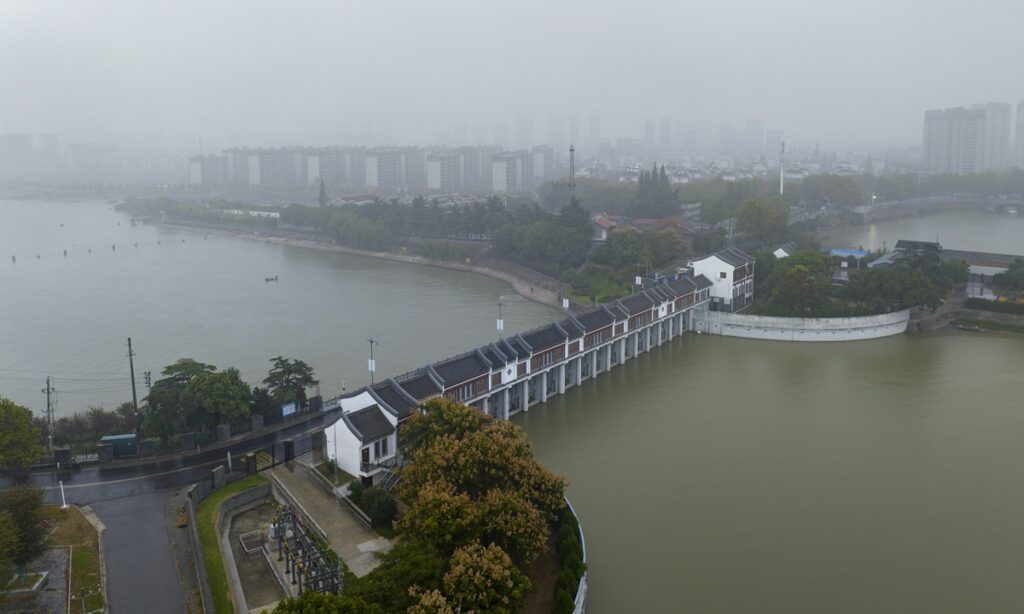Another four ancient irrigation works listed as WHIS
Including a more than 2,000-year-old water diversion dam in East China’s Anhui Province, four ancient Chinese irrigation works were recently listed as World Heritage Irrigation Structures (WHIS).
The four Chinese heritage sites are Qimenyan, also known as the “seven-door weir” in Anhui Province; the Hongze Lake Irrigation System built in AD199 in East China’s Jiangsu Province; Huoquan, a spring type water system in North China’s Shanxi Province; and the Baini Weirs, two dams in Central China’s Hubei Province.
Although these projects are generally defined as “irrigation systems,” their typologies, geographical conditions and historical value vary. Taking Qimenyan as an example, it is located in a hilly wetland environment and its main channel connected with sub-mechanisms like ponds, ditches and canals. Thus, the system could be used to store as well as distribute water.
Another iconic project, the Baini Weirs, consists of two 1,000-year-old dams that are still being used for flood control and water supply. It is a typical example of a large-scale stone-built structure in ancient China.
Yuan Han, an architectural and urban planning expert, told the Global Times that the scattered locations of these sites reveal that “water management” was a “national-level plan” in ancient China. The Chinese ingenuity in irrigation engineering equated with today’s concept of “sustainability” as it respected natural conditions.
“Yin Di Zhi Yi [lit: creating something in line with local conditions] is a major philosophy used in ancient design. It is early advice to the world from China on how to carry out sustainable development,” Yuan told the Global Times.
Including the newly added sites, China has a total of 34 irrigation projects on the WHIS list. The 2023 list was announced at the 74th International Executive Council Meeting of the International Commission on Irrigation and Drainage (ICID) in India.
A total of 15 projects from countries like India, Iraq and Turkey were all added to the 2023 list. Among them, China’s landscape of irrigation systems are the richest and have the widest distribution.
Environmental expert Jia Boyang told the Global Times that a site should have “several boxes ticked” to be considered a “heritage” site. The evaluation is not limited to looking at a site’s history or characteristics.
“A heritage site should be able to show continued value to humanity and social and cultural developments. These ancient irrigation systems across the country also reflect China’s long-standing strength in agriculture,” said Jia.
China’s “water project” heritage is an open door for many to look into the country’s agricultural history. Ancient irrigation supported not only the harvest on farms, but also the entire country’s economic development and cultural exchanges.
Besides the new batch of function-oriented sites, the Beijing-Hangzhou Grand Canal that was built during the Spring and Autumn Period (770BC-476BC) carries great social importance. Starting from Hangzhou to Beijing, the grand water belt is a major part of China’s South-to-North Water Transfer Project. It has promoted the country’s overall economic growth while allowing folk and cultural traditions to be exchanged between the northern and southern parts of China.
Founded in 1950, the ICID is an international platform dedicates to the innovative sustainability of irrigation system design and flood control around the world.
As a member of the organization, with its burgeoning technological and manufacturing powers, China has co-launched several irrigation projects overseas with countries like Egypt and Kazakhstan.
“Chinese water engineering projects reflect the country’s creative character and also the continuity of the country’s profound civilization,” said Yuan.
(Global Times)




